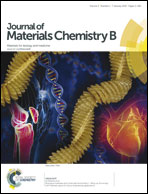Thermoresponsive PNIPAAm hydrogel scaffolds with encapsulated AuNPs show high analyte-trapping ability and tailored plasmonic properties for high sensing efficiency
Abstract
The fabrication of a scaffold able to control the positioning of AuNPs and to trap and concentrate target molecules inside them is a promising idea for a large variety of sensing applications. In this work, we designed and fabricated a scaffold of already-prepared 20 nm AuNPs encapsulated in a PNIPAAm hydrogel and utilizing surface enhanced Raman spectroscopy (SERS), we used it as a sensor with remarkably low limits of detection. In fact, as the target is trapped inside the hydrogel, the following takes place: (a) the concentration of the target increases dramatically and (b) the localization of the AuNPs and thus of the hotspots (areas with extremely high SERS enhancement factors) work synergistically, improving the sensing ability of the scaffold. The SERS enhancement ability of our scaffolds was checked with adenine, 2-naphthalenethiol and melamine molecules; the trapping efficiency was investigated for the melamine and a partition coefficient of k = 5 × 105 was found. Finally, by focusing on a single PNIPAAm hydrogel with encapsulated AuNPs, we managed to detect 10−6 M or rather 108 molecules of melamine trapped inside the scaffold.


 Please wait while we load your content...
Please wait while we load your content...